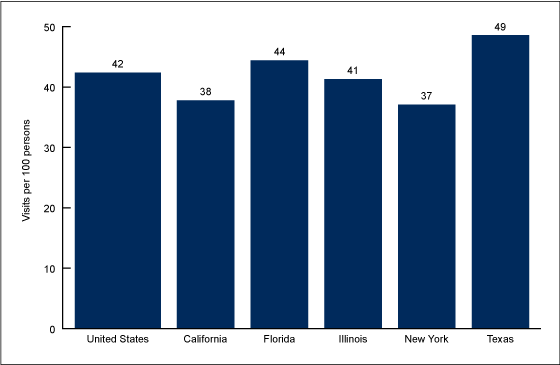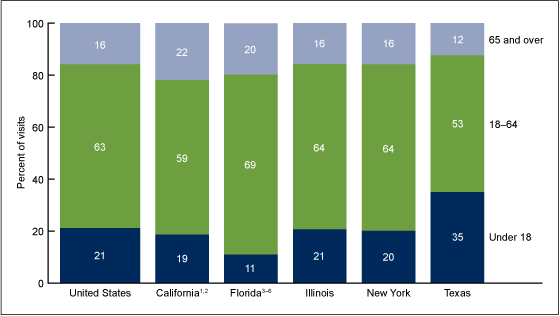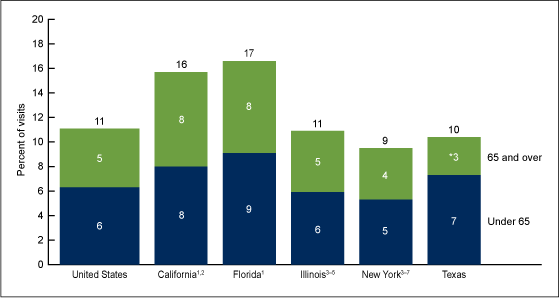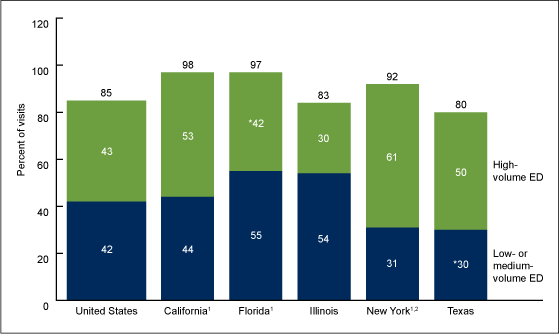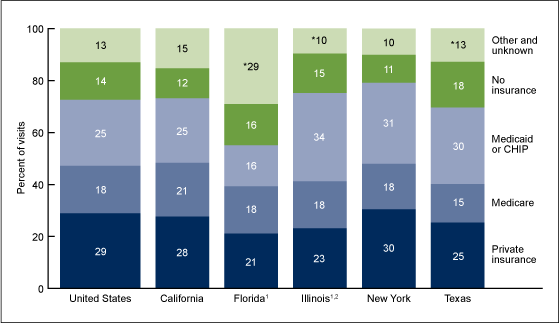Emergency Department Use in the Country’s Five Most Populous States and the Total United States, 2012
- Key findings
- Did the rate of ED visits vary among the five most populous states?
- Did the age distribution of ED visits vary among the five most populous states?
- Did admission to the hospital through EDs vary among the five most populous states?
- Did the percentage of visits made to urban EDs vary among the five most populous states?
- Did the expected primary source of payment for ED visits vary among the five most populous states?
- Summary
- Data source and methods
- About the authors
- References
- Suggested citation
NCHS Data Brief No. 252, June 2016
PDF Version (315 KB)
Esther Hing, M.P.H. and Pinyao Rui, M.P.H.
Key findings
Data from the National Hospital Ambulatory Medical Care Survey, 2012
- In 2012, the emergency department (ED) visit rate in the United States was 42 visits per 100 persons.
- The ED visit rate among the five most populous states ranged from 37 visits per 100 persons in New York to 49 visits per 100 persons in Texas.
- The percentage of ED visits resulting in admission to the same hospital was higher in California (16%) and Florida (17%) than was observed nationally (11%).
- The percentage of visits to EDs located in metropolitan statistical areas was higher in California (98%), Florida (97%), and New York (92%) than was observed nationally (85%).
In 2012, about 20% of children and adults had one or more emergency department (ED) visits during the year (1,2). This report presents ED visits for the country as well as for the five most populous states (California, Florida, Illinois, New York, and Texas). Visits are analyzed by patient and visit characteristics, as well as by hospital characteristics. Estimates are based on the 2012 National Hospital Ambulatory Medical Care Survey (NHAMCS), a nationally representative survey of visits to hospital EDs.
Keywords: hospital emergency departments, state estimates, National Hospital Ambulatory Medical Care Survey
Did the rate of ED visits vary among the five most populous states?
- Overall there were 42 visits per 100 persons in the United States (Figure 1). The rate of ED visits per 100 persons among the five most populous states ranged from 37 visits in New York to 49 visits in Texas. The visit rate in each of the five states did not differ significantly from the national rate.
- Although the observed ED visit rate in Texas was higher than the visit rates among the remaining four states, there were no significant differences in visit rates among states.
Figure 1. Emergency department visit rates, by the five most populous states: United States, 2012
NOTES: In 2012, there were an estimated 131 million visits to emergency departments (ED) in the United States. Visits in the five most populous states represent 36% of all ED visits. Visit rates are based on estimates of the civilian noninstitutionalized population of the United States, as reported by the U.S. Census Bureau Population Division. Access data table for Figure 1.
SOURCE: NCHS, National Hospital Ambulatory Medical Care Survey, 2012.
Did the age distribution of ED visits vary among the five most populous states?
- Nationwide, the majority of ED visits were made by adults aged 18–64 (63%), followed by children under age 18 (21%), and the elderly aged 65 and over (16%) (Figure 2).
- The percentage of ED visits made by persons aged 65 and over in California (22%) was higher than the national percentage (16%). This percentage was also higher than the percentages of elderly visits in Illinois (16%), New York (16%), and Texas (12%).
- The percentage of ED visits made by adults aged 18–64 in Florida (69%) was higher than the percentage of ED visits made by adults aged 18–64 in California (59%) and Texas (53%).
- The percentage of ED visits made by children in Florida (11%) was lower than the national percentage (21%). The percentage of ED visits made by children in Florida was the lowest among the five most populous states.
Figure 2. Percent distribution of emergency department visits, by patient age and the five most populous states: United States, 2012
1Statistically different from United States for 65 and over age group (p < 0.05).
2Statistically different from Illinois, New York, and Texas for 65 and over age group (p < 0.05).
3Statistically different from Texas for 65 and over age group (p < 0.05).
4Statistically different from national percentage for under 18 age group (p < 0.05).
5Statistically different from California, Illinois, New York, and Texas for under 18 age group (p < 0.05).
6Statistically different from California and Texas for 18–64 age group (p < 0.05).
NOTES: Numbers may not add to 100 due to rounding. Access data table for Figure 2.
SOURCE: NCHS, National Hospital Ambulatory Medical Care Survey, 2012.
Did admission to the hospital through EDs vary among the five most populous states?
- Nationwide, 11% of ED visits resulted in admission to the same hospital; almost one-half of these visits (5%) were made by elderly persons aged 65 and over (Figure 3).
- The percentage of ED visits resulting in admission to the same hospital was higher in California (16%) and Florida (17%) than was observed nationally (11%). The percentages of ED visits admitted to the same hospital in California and Florida also exceeded comparable percentages in Illinois (11%) and New York (9%).
- In California, a higher percentage of ED visits made by elderly persons aged 65 and over were admitted to the same hospital (8%) compared with the percentage observed nationally (5%). The percentages of elderly visits admitted to the same hospital in California and Florida (both 8%) exceeded the comparable percentage in New York (4%). The California estimate also exceeded the estimate in Illinois (5%).
- The percentage of nonelderly ED visits admitted to the same hospital in each of the five states was similar to the percentage observed nationally. The percentage of nonelderly ED visits admitted to the same hospital in New York (5%) was lower than in California (8%) and Florida (9%).
Figure 3. Emergency department visits resulting in admission to same hospital, by the five most populous states: United States, 2012
* Estimate does not meet standards of reliability or precision.
1Statistically different from national percentage (p < 0.05).
2Statistically different from national percentage for 65 and over age group (p < 0.05).
3Statistically different from California percentage for all ages (p < 0.05).
4Statistically different from California for 65 and over age group (p < 0.05).
5Statistically different from Florida percentage for all ages (p < 0.05).
6Statistically different from Florida for 65 and over age group (p < 0.05).
7Statistically different from California and Florida for under 65 age group (p < 0.05).
NOTE: Access data table for Figure 3.
SOURCE: NCHS, National Hospital Ambulatory Medical Care Survey, 2012.
Did the percentage of visits made to urban EDs vary among the five most populous states?
- Nationwide, 85% of ED visits were made to EDs located in metropolitan statistical areas (MSAs); and 43% of ED visits occurred in high-volume MSA EDs, defined as those with 50,000 annual visits or more (Figure 4).
- The percentage of visits to EDs located in MSAs was higher in California (98%), Florida (97%), and New York (92%) than was observed nationally (85%).
- The percentage of visits to high-volume MSA EDs ranged from 30% in Illinois to 61% in New York.
- The percentage of visits to high-volume MSA EDs in New York (61%) was higher than the percentage observed in Illinois (30%) but similar to the percentages in California (53%), Florida (42%), and Texas (50%).
Figure 4. Emergency department visits that were made to urban metropolitan statistical areas, by the five most populous states: United States, 2012
* Estimate does not meet standards of reliability or precision.
1Statistically different from national percentage (p < 0.05).
2Statistically different from percentage of visits to high-volume EDs in Illinois (p < 0.05).
NOTES: ED is emergency department. High-volume EDs have 50,000 annual visits or more; low- or medium-volume EDs have less than 50,000 annual visits. Numbers may not add to totals due to rounding. Access data table for Figure 4 .
SOURCE: NCHS, National Hospital Ambulatory Medical Care Survey, 2012.
Did the expected primary source of payment for ED visits vary among the five most populous states?
- Nationwide, private insurance was the expected payment source for 29% of ED visits, followed by Medicaid or Children’s Health Insurance Program (CHIP) (25%), Medicare (18%), no insurance (14%), and other and unknown insurance (13%) (Figure 5).
- The percentage of ED visits with Medicaid or CHIP as the expected payment source in Illinois (34%) was higher than the national percentage (25%), while the percentage of ED visits with private insurance (23%) was lower than the national percentage (29%).
- The percentage of ED visits with Medicaid or CHIP as the expected payment source in Florida (16%) was lower than the national percentage (25%).
Figure 5. Expected primary source of payment for emergency department visits, by the five most populous states: United States, 2012
* Estimate does not meet standards of reliability or precision.
1Statistically different from national percentage for Medicaid or CHIP (p < 0.05).
2Statistically different from national percentage for private insurance (p < 0.05).
NOTES: No insurance includes self-pay, charity, or no charge. CHIP is Children’s Health Insurance Program. Twenty two percent of Medicare estimates are dually eligible for Medicare and Medicaid. Other and unknown includes workers compensation, other payment source, unknown, or blank. Estimates include 9% of visits with unknown or blank payment source. Numbers may not add to 100 due to rounding. Access data table for Figure 5.
SOURCE: NCHS, National Hospital Ambulatory Medical Care Survey, 2012.
Summary
ED visits in the five most populous states (California, Florida, Illinois, New York, and Texas) represent 36% of all ED visits in 2012. This report presents selected characteristics of ED visits in those five states and the United States. Some of the observed differences are notable but not significant because there were too few cases to detect significant differences.
During 2012, an estimated 131 million visits were made to EDs in the United States for a visit rate of 42 visits per 100 persons. The visit rates in the five states ranged from 37 visits per 100 persons in New York to 49 visits per 100 persons in Texas, but the visit rates for the five states did not differ significantly from the national rate or from each other (3,4). However, the percentage of ED visits made by the elderly in California (22%) was higher than was observed nationally (16%), and the percentage of ED visits made by children under age 18 in Florida (11%) was lower than the national percentage (21%).
In 2012, the percentages of ED visits resulting in hospital admission was higher in California (16%) and Florida (17%) compared with the country (11%). In California, the percentage of elderly ED visits resulting in hospital admissions was higher than was observed nationally. The percentage of visits to EDs located in MSAs was higher in California (98%), Florida (97%), and New York (92%) than was observed nationally (85%). In 2012, 43% of all ED visits occurred in high-volume EDs located in MSAs, unchanged since 2007, when high-volume EDs in MSAs accounted for 44% of all ED visits (5).
The primary expected payment source for ED visits varied among the five states. In Illinois, the percentage of ED visits with Medicaid or CHIP (34%) was higher than the national percentage (25%), while the comparable percentage in Florida (16%) was lower than the national percentage.
Data source and methods
Data for this report are from NHAMCS, which is conducted by the National Center for Health Statistics. NHAMCS is an annual, nationally representative survey of visits to hospital-based outpatient departments, EDs, and ambulatory surgery centers. The survey uses a multistage probability sample design. In 2012, the sample was supplemented with additional hospitals to permit estimates for the country, as well as the five most populous states (California, Florida, Illinois, New York, and Texas). The survey data are weighted to produce unbiased national annual estimates of hospital-based ambulatory visits (6). The unweighted ED response rate was 76.3% (75.3% weighted). Additional information on the methodology of NHAMCS has been described previously (6).
Analyses included visits from the ED component of NHAMCS for the country and five states. Data analyses were performed using the statistical packages SAS version 9.3 (SAS Institute, Cary, N.C.), and SAS-callable SUDAAN version 11.0 (RTI International, Research Triangle Park, N.C.). The hospital location of the ED was used to generate state-level estimates. Statements of difference in estimates are based on two-tailed t tests with significance at the p < 0.05 level.
About the authors
Esther Hing is with the National Center for Health Statistics, Division of Health Care Statistics. Pinyao Rui is with Global Evaluation & Applied Research Solutions (GEARS), Inc.
References
- Blackwell DL, Lucas JW, Clarke TC. Summary health statistics for U.S. adults: National Health Interview Survey, 2012. National Center for Health Statistics. Vital Health Stat 10(260). 2014.
- Bloom B, Jones LI, Freeman G. Summary health statistics for U.S. children: National Health Interview Survey, 2012. National Center for Health Statistics. Vital Health Stat 10(258). 2013.
- The Kaiser Commission on Medicaid and the Uninsured. States getting a jump start on health reform’s Medicaid expansion. Issue Brief April 2, 2012.
- Rasmussen PW, Collins SR, Doty MM, Beutel S. Health care coverage and access in the nation’s four largest states. Issue Brief April 2015. Commonwealth Fund pub 1810 Vol 7. 2015.
- McCaig LF, Xu J, Niska RW. Estimates of emergency department capacity: United States, 2007. NCHS health e-stats. 2009.
- National Center for Health Statistics. 2012 NHAMCS micro-data file documentation. 2016.
Suggested citation
Hing E, Rui P. Emergency department use in the country’s five most populous states and the total United States, 2012. NCHS data brief, no 252. Hyattsville, MD: National Center for Health Statistics. 2016.
Copyright information
All material appearing in this report is in the public domain and may be reproduced or copied without permission; citation as to source, however, is appreciated.
National Center for Health Statistics
Charles J. Rothwell, M.S., M.B.A., Director
Jennifer H. Madans, Ph.D., Associate Director for Science
Division of Health Care Statistics
Clarice Brown, M.S., Director
Alexander Strashny, Ph.D., Associate Director for Science
